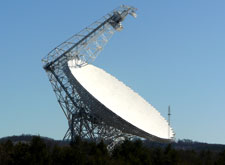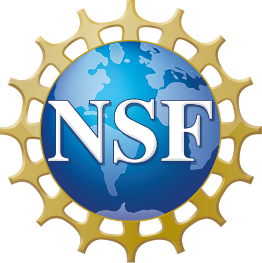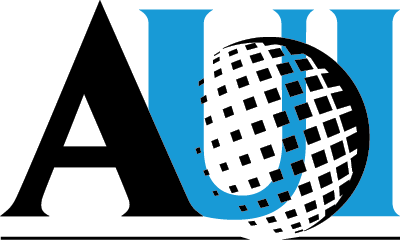Green Bank Electronics Division Tools
Major Test Equipment, Engineering Software, and other resources
The following provides a list of major test equipment, engineering
software, and other resources available at the NRAO site in Green Bank,
WV.
An ethernet local area network is available in all offices and
laboratories, providing access to shared computer resources and the
internet.
Microwave Test Equipment
Vector Network Analyzers
- Anritsu 37397C Lightning VNA with time domain, 0.04-65.0 GHz in coax, with Oleson Microwave waveguide extender modules for 60-94 GHz in WR12, and 75-115 GHz in WR10. A Karl-Suss PM5 manual wafer probe machine is adjacent to the VNA, allowing on-wafer RF testing to 115 GHz.
- HP 8720B VNA, 130MHz-20GHz with time domain.
- HP 8753A VNA, 300kHz-3 GHz.
Noise Measurement
- Agilent N8793A Noise Figure/Gain Analyzer, 10MHz-3GHz. Can control LOs to extend frequency range by using external converters.
- NRAO built liquid nitrogen hot/cold loads and test sets for semi-automated swept noise temperature measurements.
Power Measurement
- HP 436,437 Power Meter (3).
- Agilent E4418B Power Meter (2).
- Agilent E4416A Peak Power Meter with E9327A Peak Power Sensor.
- Agilent 8487A,D 0.05-50GHz Power Sensors in 2.4mm Coax.
- Agilent 8486 Waveguide Power Sensors in WR28,22,15, and 10 (26.5-110 GHz).
- Other coaxial power sensors to 18 GHz.
Signal Sources
- HP 83620A Synthesized Sweeper, 10MHz-20 GHz.
- HP 83712B Synthesized Source, 10MHz-20 GHz.
Spectrum Measurement
- HP 8566B Spectrum Analyzer, 100Hz-2.5GHz / 2-22 GHz.
- HP 8563A Spectrum Analyzer, 9KHz-26.5GHz with external harmonic mixer for 26-40GHz.
- Advantest R3261A Spectrum Analyzer, 9kHz-2.6 GHz.
- Motorola R2009D Communications Service Monitor.
- HP 3561A Dynamic Signal Analyzer, 0.125millihertz-100kHz (2).
- Tektronix 2755P Spectrum Analyzer, 50KHz-21GHz.
- HP 3048A Phase Noise Analyzer - a rack mounted system that includes an 8663A signal generator, a 3585A spectrum analyzer, other instruments, and control and measurement software.
Digital Test Equipment
Optical Fiber Equipment
- Sumitomo Type 35 Fusion Splicer
- Photon Kinetics Model 4000 Optical Time Domain Reflectometer
Cryogenics
- Alcatel ASM142 Leak Detector
- Swagelok CWS-D100 Orbital TIG Tubing Welder
Engineering Software
EM/Optics Analysis
- CST's Microwave Studio is available on the local network.
- Focus Software's Zemax (Optical raytrace and design program).
Microwave Design
- Applied Wave Research's Microwave Office (circuit analysis, optimization, and layout) is available on the local network.
- Optotek's MMICAD (circuit analysis and optimization) is available on the local network.
General Circuit Design
- Intusoft's ICAP/4Rx Interactive Spice.
Drafting
- Autodesk's Autocad is available on the local network.
Assembly Equipment
- Westbond 747677E-79 combination ball and wedge ultrasonic bonder.
- Hand-held tools for surface-mount circuit repair and assembly.
Antenna Ranges
Outdoor Antenna Range
An outdoor antenna range is located on the Green Bank site. Two 32 foot towers, one fixed and one movable, give range distances of 12 to 48 feet. The motor-driven feed positioner on the fixed receive tower allows lateral and focus movements as well as azimuth sweeps of the feed under test. A Scientific Atlanta 1754 receiver, and a series of harmonic mixers and standard transmit horns, allow feeds to be measured at most frequencies between 100 MHz and 40 GHz.
Indoor Antenna Range
A shielded anechoic chamber measuring 15 by 15 by 37 feet is located in
the Jansky Laboratory at Green Bank. This chamber has been
outfitted as a far-field antenna range. The anechoic chamber was
designed and specifed for the frequency range 10-94 GHz. The absorber
in the room is a combination of AEP-6 and AEP-8; this absorber is
described in this
data sheet. Maximum distance from transmit to receive antennas is
22 feet. Instrumentation for the range allows far-field measurements
from 2 to 115 GHz, but the actual range possible depends upon the size
of the feed, the dynamic range requirements, and other constraints.
Test and
source antennas are mounted 7-1/2 feet above the floor of the
chamber (along the axis
of symmetry of the chamber) to minimize reflections. Orbit/FR's
software package (FR-959) allows fully-automated control
of the range receiver, and of 5 axies as
follows:
- Antenna Under Test (AUT) Azimuth rotation
- AUT Y axis translation (toward and away from source antenna)
- AUT X axis translation (in the horizontal plane and at right angles to the Y translator)
- AUT Polarization rotation
- Source Antenna Polarization rotation
From 2 GHz to 50 GHz, measurements are made using the Agilent 85320A-H50 Mixer Module which rides on the antenna side of the polarization positioner. In this configuration, all 5 axies of the range are available to the user. Our equipment does not cover the range from 50 to 60 GHz, as this frequency range is not commonly used in radio astronomy due to oxygen absorbtion. Above 60 GHz extension heads from Oleson Microwave are used. There were bought and are normally used with an Anritzu "Lightning" Network Analyzer and cover the frequency range of 60-95 GHz (WR-12 waveguide) and 75-115 GHz (WR-10 wageguide). Polarization positioners may not be used above 50 GHz as we have no rotary joints for these frequencies. Polarization changes during test must be made manually, using waveguide twists. To use the chamber please contact Carla Beaudet (GB-2126). The anechoic chamber is a dual-use facility, and spends some of its time configured for RFI testing; at least two weeks of advance notice will assist us in planning for your visit.
RFI Measurements
The shielded anechoic chamber (described under Indoor Antenna Range) is a useful facility for measurement of RFI emissions from equipment, either purchased or designed in-house. Instrumentation available allows absolute measurements from 100-1000 MHz.



